

Do 17Z

The Dornier Do17Z was to be the definitive
development of the Do 17 series and was based on the M version and
experience gained in with earlier versions in combat usage. In this
version the entire forward fuselage was changed. The 17 series had
always had rather cramped crew quarters and on the Z version the roof
was raised and fully glazed. The bombardiers station was glazed with
flat panels and the lower part of the fuselage was bulged and extended
aft to a point near the leading edge of the wing, terminating in a
position for a rearward and down facing machine gun position.
Additional gun locations were added to the rear portion of the cockpit.
The Z-1, which was first produced near the end of 1938, was essentially
the same airframe as the M-1 apart from the new forward fuselage and
performance remained the same in spite of the increase in drag. It
retained the good handling characteristics of its predecessor but the
additional crew member and armament caused it to be underpowered when
carrying the maximum bomb load and this was reduced to 1000 lb. The
bomb load was restored in early 1939 when the 17Z-2 equipped with
engines with two stage superchargers became available. The original
bomb load of 2,205 lb. could then be carried but at the cost of range.
The 17Z-3 carried automatic cameras in the entry hatch. The 17Z-4 was a
field modification to a dual control trainer and the 17Z-5 was fitted
with flotation bags and additional life saving equipment to make it
suitable to long range over water reconnaissance missions. The aircraft
was said to be popular with both flying and ground crews and was the
most reliable of all the Luftwaffe bombers but it lacked the bomb load
of the He 111 and the speed of the Ju 88 and production was terminated
in the Summer of 1940. The total number of Z's produced was around 500.
The Kit
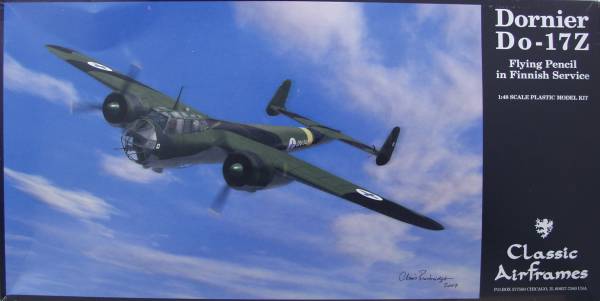
When word was released that Classic Airframes would
be doing a Do17Z it was great news as the only other extant 1/48 scale
kit was the Hobbycraft version which was at best lackluster and beset
with errors including the banana fuselage and lacking good interior
detail. From the looks of things CA has not let us down. The kit comes
in a two part box that is a bit thin but adequate, with a nice looking
rendition of the 17Z in flight. Inside the box is a large zip lock bag
containing the five main sprues, a smaller zip lock bag with the resin
parts and a sealed plastic bag with the clear parts. While the zip lock
bag for the main parts is nice in that it can be resealed to keep parts
from sneaking away, I would have preferred to see each of the sprues
bagged separately. There was some scuffing on the parts from shipping
and a few parts that had come loose from the sprues.
The parts all have a nice smooth glossy finish and the panel lines are
nicely engraved (to my eye anyway, the ones Tamiya and some others use
always look too wide and deep to me) but they may not be deep enough
once its painted for washes to work well. The main parts appear free of
surface defects. The only sink mark I found was a small one of the
backside of each of the main landing gear struts. The small parts had
light flash and mold parting lines that will need to be cleaned up. I
found no ejector pin marks anywhere that would show such as the inside
of landing gear or bomb bay doors. There are a couple ejector towers
inside the bomb bay you will want to remove if you display the kit with
the bomb bay doors open and others on the inside mating surfaces of the
horizontal tail halves that will need to be removed prior to
assembly.
The vertical tail fins and rudders are one piece
moldings. All of the control surfaces are molded integral to the wings
and tail. Some of the injection gates are heavier than that of the main
stream kits so some care will need to be exercised removing parts from
the sprues. The fuselage has been divided to make future versions
possible. The main fuselage from the forward edge of the wing back is
split vertically while the forward portion is split horizontally to
make it easier to install the interior parts. With this set up it
should be possible to make most of the Do 17 versions the E/F, M/P, K,
215 and the night fighter versions. I don't know what CA has planned
but I imagine that they will want to get a maximum return on the
investment in the dies. There are five sprues of a medium gray plastic
with 104 parts on them, two are identical so only four are shown below.
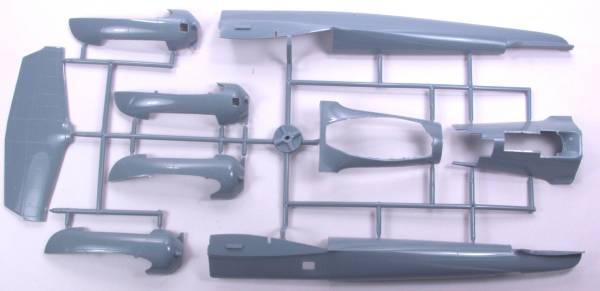
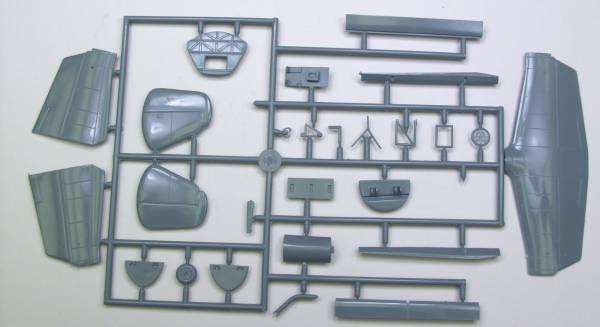
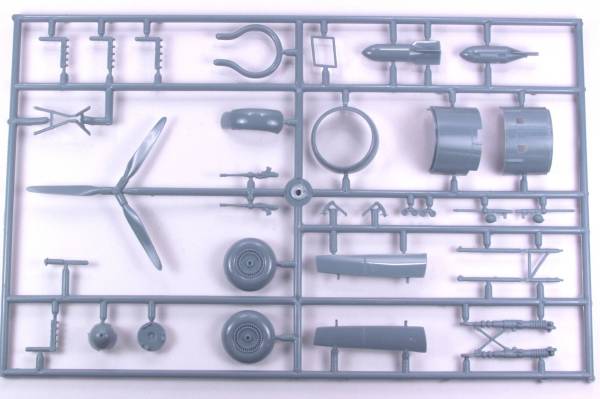
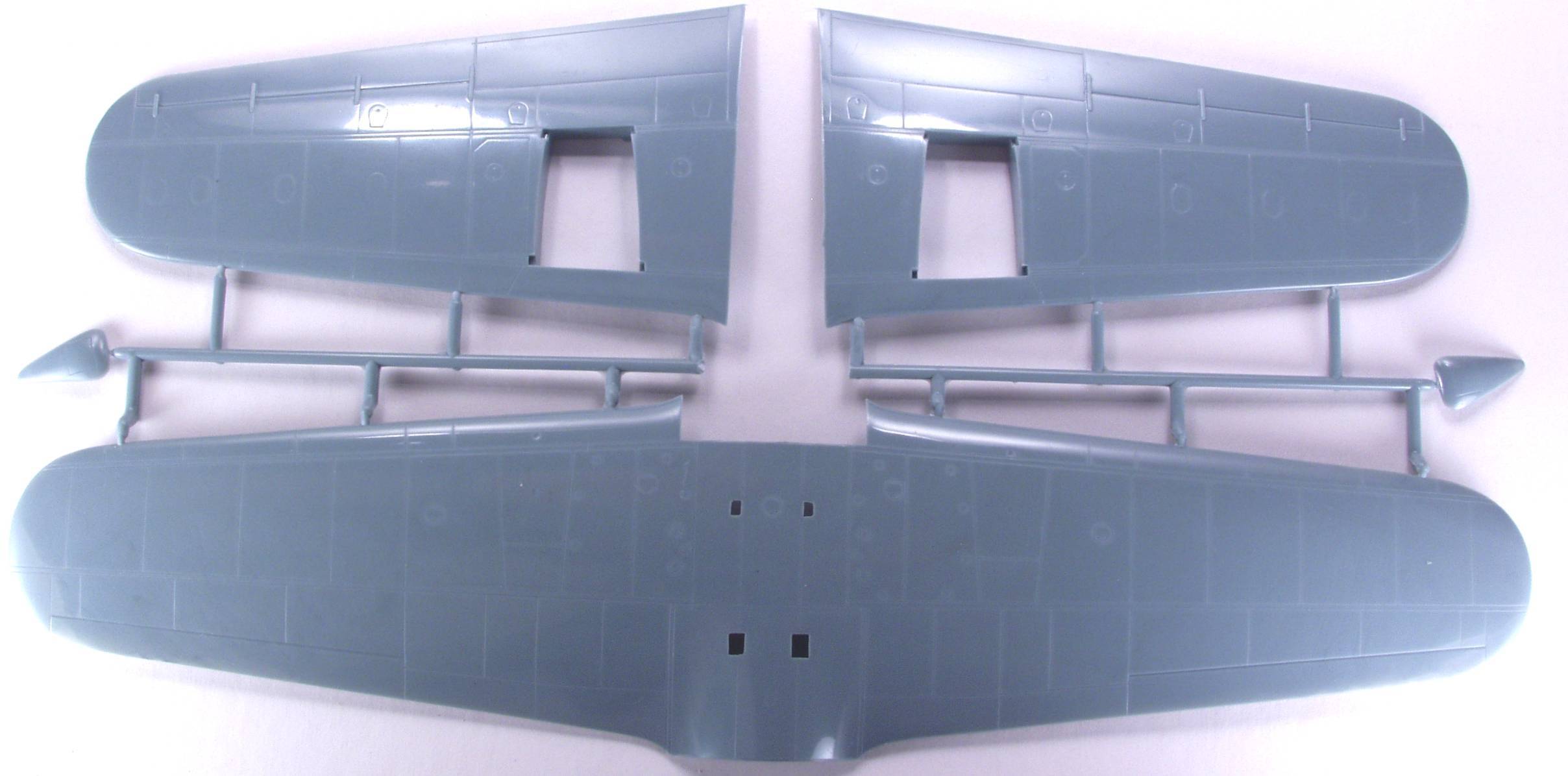
The bag of resin parts contains 19 cream colored
parts consisting of the two engines, cockpit seats, cockpit side panel
details, bomb bay parts, instrument panel, tail wheel housing, air
scoops, and bomb sight. All parts were crisply molded with no voids or
pinholes that I could find on casual inspection. There was some light
flash but it should clean up easily. All parts were intact. The two
crew seats were very delicate and some care will need to be exercised
when handling and cleaning them. The instrument panel has raised detail
for bezels and switches but no raised detail for the instruments
themselves. The backside has raised detail for the instruments. See
below.
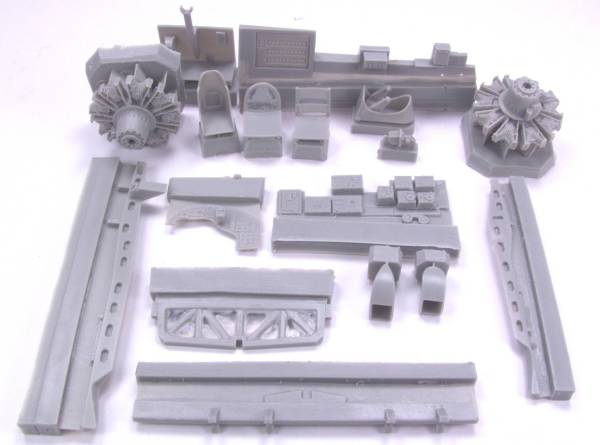
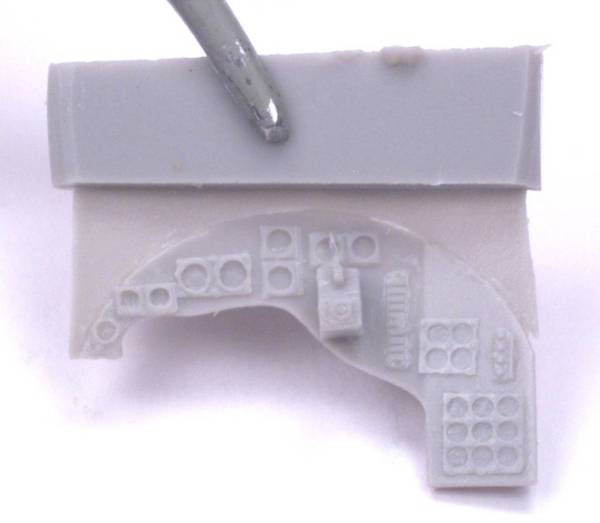
There are nine clear parts, which are thin and transparent with good demarcation for the framing and should look great with a coat of Future.
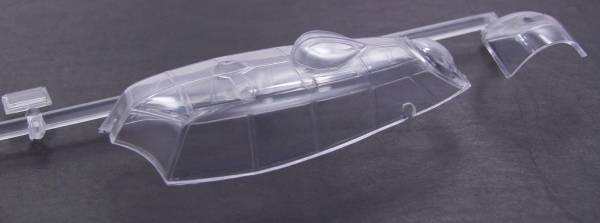
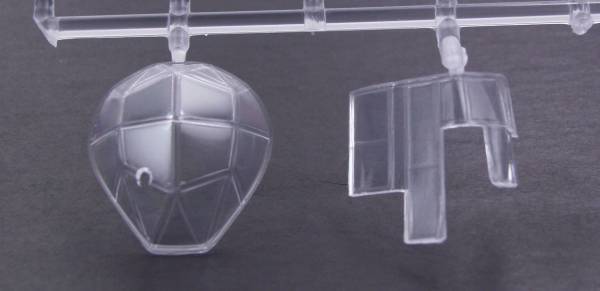
The cockpit is built up of both plastic and resin parts with enough detail to make for a great looking pit. The machine guns are nicely molded with separate ammunition cases. This view below from the instruction sheet below gives an idea of the level of detail in the cockpit.
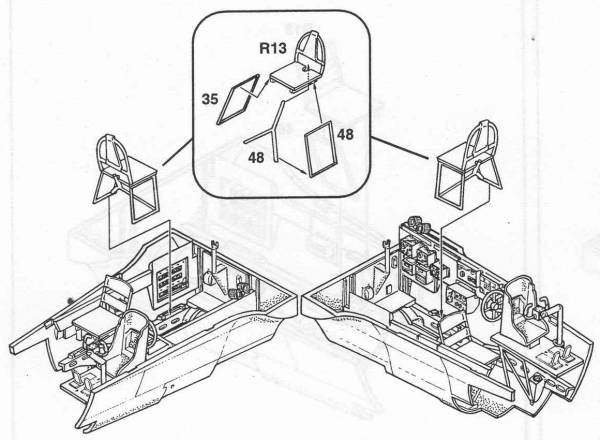
The bomb bay is also well detailed with bomb racks and ribs molded into the upper surface and the kit comes with two 250-kg bombs. The view below from the instruction sheet shows you the level of detail in the bomb bay.
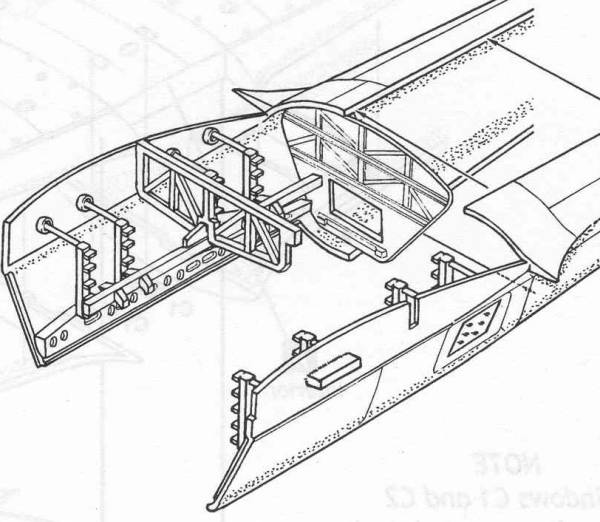
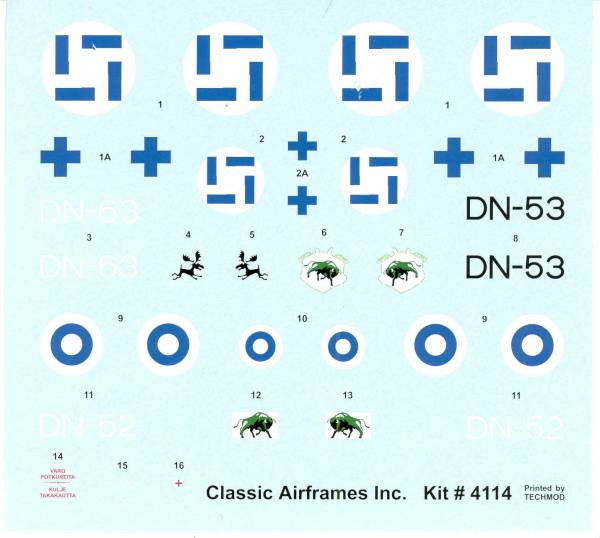
The instructions are printed on two legal sized pages
(8 1/2" x 14") that are folded in half to create 8 pages. The first
page has history and specifications. The second page has a part map for
the sprues and a color guide calling out colors in RLM numbers where
necessary with FS numbers and the rest are just generic colors. The
balance is for assembly. A second sheet is supplied printed on one side
with painting and marking detail for the three aircraft on the decal
sheet.
Initial Conclusions
The
kit appears accurate in outline and dimension and I'm very pleased that
CA decided to release this kit. CA doesn't mention which version of Z
this is but the information I have states that early in 1942 Goring
gave the Finnish Air Force 15 ex-Luftwaffe Do 17Z-2's, So Z-2's they
must be although it would be difficult from the outside to tell the
versions apart. Looking over the kit I noticed a few details that were
missed. Although not all 17Z's had them, the three shown in the
painting profiles have loop antennas that the kit does not supply.
Also, the 17 had fabric covered control surfaces that are not
rendered on the kit. This may actually be a blessing as they usually
tend to be overdone and looking at photographs they really don't show
up that well except for being slightly lighter in color. Also missing
from the external details is the towel rack antenna on the lower
fuselage and the slanted tube for the retractable long wire antenna,
although there is a recess in the fuselage where this should mount. The
ailerons are missing trim tabs. CA also missed a couple of things in
the tail area, for one the starboard fin and rudder on the prototype
were angled at 3.5º and there is a prominent hump over the
horizontal tail plane and all of these were overlooked. Interestingly
enough Hobbycraft did not. The missing antennas are shown on their
painting profiles and none would be that difficult to do from scratch.
The other issues would be more difficult to fix.
The engines have a hole molded in the front for a propeller shaft but
there is not one included with the kit. The propellers are one piece
with a separate spinner and spinner backing plate. The backing plate
has a small nub only, which would not be strong enough if just glued to
the engine so you will want to drill it out and make your shaft. The
most glaring oversight, in my opinion anyway, was not including the
engine to cowling bracing. This is very prominent when looking at
photos. I was hoping these would be included, as it is very difficult
to tell from looking at photos the exact arrangement and doing it
yourself could be tedious and fussy. Some kits model these as if they
were symmetrical pairs of V's but I'm not convinced that such an
arrangement is entirely accurate. In most photos the braces are in
shadow and are easily confused with the push rod covers as they are
close to the same size and often appear to be the same color. Perhaps
CA couldn't figure it out either. Hopefully one of the after market
suppliers will address the issue. As with most limited run kits there
no alignment pins and there are some fit issues, at least one
concerning the cowling to wing fit has been reported. Test fitting of
all parts before assembly is advised.
In spite of the aforementioned items this is still a really nice kit
and light years better than the Hobbycraft kit as far as detail is concerned and I would recommend it
to anyone who has built a few limited run kits.
I'm hoping that their choice for the next variant will be a 215 as it
only requires different engines but I guess we'll see what the future
brings.
Links to kit build or reviews
A review and build can be found here.
References
Warplanes of the Third Reich by William Green
AirDOC Photo Archive No. 3 Dornier Do 17 E-Z by Manfred Griehl
Dornier Do 17 by Edward Kocent-Zielinski
The Flying Pencil by Heinz J. Nowarra
Updated 5/9/08